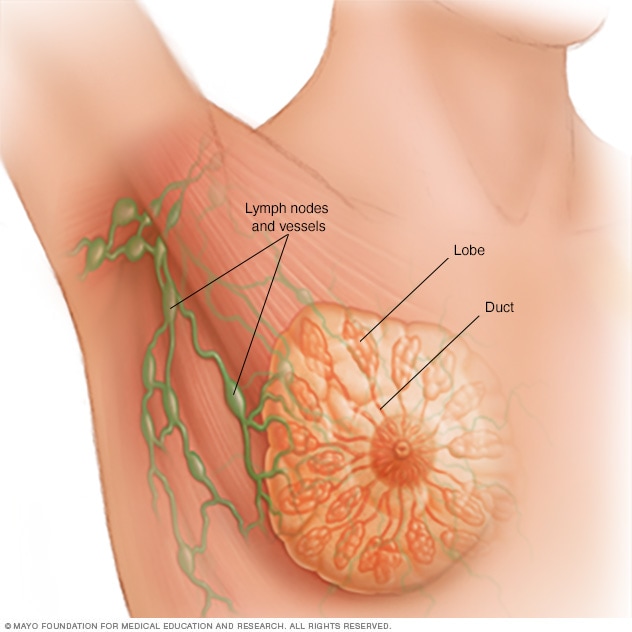Causes
Breast anatomy

Breast anatomy
Each breast contains 15 to 20 lobes of glandular tissue, arranged like the petals of a daisy. The lobes are further divided into smaller lobules that produce milk for breastfeeding. Small tubes, called ducts, conduct the milk to a reservoir that lies just beneath the nipple.
Inflammatory breast cancer happens when cells in the breast develop changes in their DNA. A cell's DNA holds the instructions that tell the cell what to do. In healthy cells, the DNA gives instructions to grow and multiply at a set rate. The instructions tell the cells to die at a set time. In cancer cells, the DNA changes give different instructions. The changes tell the cancer cells to make many more cells quickly. Cancer cells can keep living when healthy cells would die. This causes too many cells.
Most often the DNA changes happen in a cell in one of the tubes, called ducts, that can carry breast milk to the nipple. But the cancer also can begin with a cell in the glandular tissue, called lobules, where breast milk can be produced.
In inflammatory breast cancer, the cancer cells break away from where they started. They travel to the lymphatic vessels in the breast skin. The cells grow to clog the vessels. The blockage in the lymphatic vessels causes skin color changes, swelling and dimpled skin. This skin is a classic sign of inflammatory breast cancer.
Risk factors
Factors that increase the risk of inflammatory breast cancer include:
Being female
Women are much more likely than men to get breast cancer, including inflammatory breast cancer. Everyone is born with some breast tissue, so anyone can get breast cancer.
Being younger
Inflammatory breast cancer is more frequently diagnosed in people in their 40s and 50s.
Being Black
Black people have a higher risk of inflammatory breast cancer than do white people.
Being obese
People who are obese have a greater risk of inflammatory breast cancer.
Prevention
Making changes in your daily life may help lower your risk of breast cancer. Try to:
Ask about breast cancer screening
Talk with your doctor or other healthcare professional about when to begin breast cancer screening. Ask about the benefits and risks of screening. Together, you can decide what breast cancer screening tests are right for you.
Become familiar with your breasts through breast self-exam for breast awareness
You may choose to become familiar with your breasts by occasionally inspecting them during a breast self-exam for breast awareness. If you find a new change, lumps or other unusual signs in your breasts, tell a healthcare professional right away.
Breast awareness can't prevent breast cancer. But it may help you to better understand the look and feel of your breasts. This might make it more likely that you'll notice if something changes.
Drink alcohol in moderation, if at all
If you choose to drink, limit the amount of alcohol you drink to no more than one drink a day. For breast cancer prevention, there is no safe amount of alcohol. So if you're very concerned about your breast cancer risk, you may choose to not drink alcohol.
Exercise most days of the week
Aim for at least 30 minutes of exercise on most days of the week. If you haven't been active lately, ask your healthcare professional whether exercising is OK and start slowly.
Limit hormone therapy during menopause
Combination hormone therapy may increase the risk of breast cancer. Talk with a healthcare professional about the benefits and risks of hormone therapy.
Some people have symptoms during menopause that cause discomfort. These people may decide that the risks of hormone therapy are acceptable to get relief. To reduce the risk of breast cancer, use the lowest dose of hormone therapy possible for the shortest amount of time.
Maintain a healthy weight
If your weight is healthy, work to maintain that weight. If you need to lose weight, ask a healthcare professional about healthy ways to lower your weight. Eat fewer calories and slowly increase the amount you exercise.